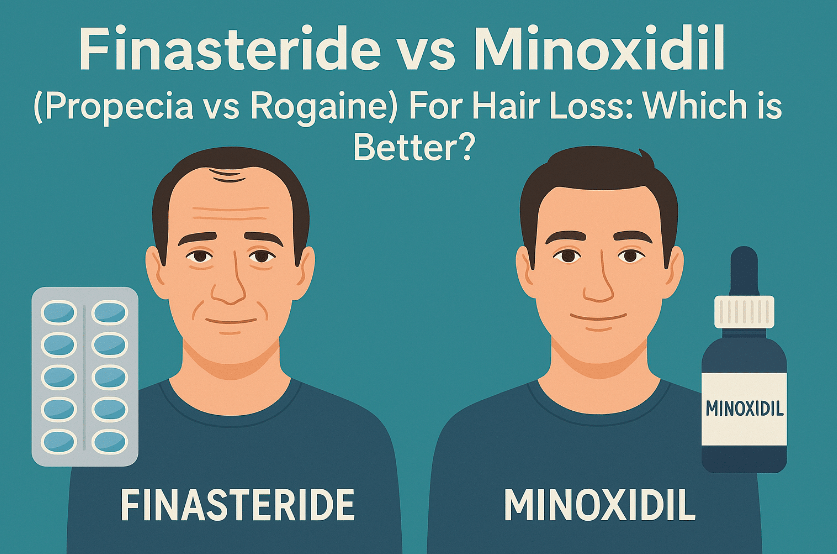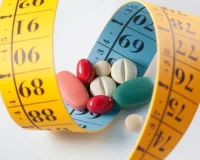Many men who come to me with questions about hair loss have only heard of Finasteride vs Minoxidil. These two treatments work in different ways, which is why it helps to understand how each one works before making a choice. Both can be effective for male pattern baldness, but the results and the possible side effects are not the same. That is usually what guides which option ends up being the better fit for someone.
How Finasteride Works
Finasteride is a daily prescription pill that targets the hormonal driver of male pattern baldness. In simple terms, it lowers the levels of a hormone called dihydrotestosterone (DHT). DHT is what causes hair follicles in genetically sensitive men to gradually shrink, producing thinner and weaker hairs until growth eventually stops. By reducing DHT, finasteride helps protect the follicles that are still active, which often means slowing hair loss and, in many cases, allowing hair to come back in areas that have only started thinning.
How Minoxidil Works
Minoxidil is usually applied as a liquid or foam directly on the scalp. It does not affect hormones. Instead, it keeps scalp blood vessels open, improving blood flow to hair roots. This extra circulation helps follicles stay active longer, which can make hair grow thicker. Some doctors also prescribe low doses of minoxidil in pill form, which has become more common in recent years. This is why people now compare oral minoxidil vs finasteride when looking at safety and effectiveness. (Frontiersin.org)
Finasteride vs Minoxidil Side Effects
The side effects of these two treatments differ. With finasteride, the main concern comes from changes in hormones. A few men report issues with sexual function, such as lower sex drive, trouble keeping an erection, or noticing less semen. These problems are not common, but possible.
Minoxidil usually causes mild scalp irritation, like itching, dryness, or flaking. When taken as a pill, however, it can affect the rest of the body, leading to swelling in the legs, shifts in blood pressure, or extra hair growth on places like the face or arms. Because of these risks, oral minoxidil should only be used under a doctor’s supervision.
Does Minoxidil Work Without Finasteride?
I am often asked if minoxidil works on its own without finasteride. The short answer is yes, it can. Minoxidil by itself can make hair look fuller and help with early thinning, especially in younger men. The challenge is that it does not block DHT, which is the hormone that causes male pattern baldness in the first place. This means that while minoxidil may thicken the hair you still have, the underlying process of hair loss can continue. For that reason, many men do better when the two treatments are used together. Finasteride protects the follicles from DHT, while minoxidil gives them more support to grow.
Expected Results from Treatment
Finasteride usually works best at keeping the hair you already have, especially on the crown and middle of the scalp. Most men notice less shedding after three to six months, with clearer improvement within a year.
Minoxidil is more noticeable for thickening and density. Some men see results as soon as four months if used consistently. Both treatments, however, only work as long as you continue them. If either one is stopped, gains fade and hair loss returns.
Choosing the Right Treatment
The choice between finasteride and minoxidil is not the same for everyone. It usually comes down to what a patient is comfortable with, their medical background, and how they feel about possible side effects. Some men would rather stay away from medications that affect hormones, so they try minoxidil first. Others want to go straight to the source of the problem and use finasteride. In some situations, low-dose oral minoxidil can also be considered, but that should only be done under a doctor’s supervision because of the way it can affect the rest of the body.
Final Thoughts
There is no single answer when comparing finasteride vs minoxidil. Neither treatment is always better. It depends on personal goals and how the body responds. In many cases, using both gives the strongest results since one slows the hormone process while the other supports growth. The most reliable way to decide is to talk with a doctor who can look at your individual situation and help guide the choice.
Want to learn more about finasteride and other hair loss treatments? Check out this guide: https://www.rocketmeds.store/finasteride-vs-other-treatments/






